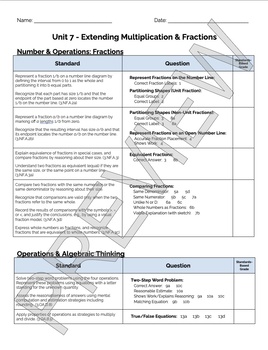Bridges 3rd Grade Standards Based Post-Assessment Cover Sheet: Unit 7
Data Driven Design
1 Follower
Grade Levels
3rd
Subjects
Resource Type
Standards
CCSS3.NBT.A.3
CCSS3.OA.B.5
CCSS3.OA.D.8
CCSS3.NF.A.2a
CCSS3.NF.A.2b
Formats Included
- Google Docs™
Data Driven Design
1 Follower

Made for Google Drive™
This resource can be used by students on Google Drive or Google Classroom. To access this resource, you’ll need to allow TPT to add it to your Google Drive. See our FAQ and Privacy Policy for more information.
Also included in
- If you are working in a standards-based grading system, you might find it challenging to grade Bridges post-assessments using the MLC spreadsheets. Use these cover sheets to support your communication with parents/families in a standards-based format that also supports your standards-based grade booPrice $15.00Original Price $21.00Save $6.00
Description
If you are working in a standards-based grading system, you might find it challenging to grade Bridges post-assessments using the MLC spreadsheets. Use these cover sheets to support your communication with parents/families in a standards-based format that also supports your standards-based grade book.
You may also consider using these coversheets as tools for student reflection.
Suggested use:
- Complete a cover sheet for each student, circling the problem number(s) that are incorrect, allowing you to determine the standards-based grade within the rows of each domain.
- Staple the cover sheet onto the assessment for parents/students to better understand academic performance from a standards-based lens.
Total Pages
Answer Key
N/A
Teaching Duration
N/A
Report this resource to TPT
Reported resources will be reviewed by our team. Report this resource to let us know if this resource violates TPT’s content guidelines.
Standards
to see state-specific standards (only available in the US).
CCSS3.NBT.A.3
Multiply one-digit whole numbers by multiples of 10 in the range 10–90 (e.g., 9 × 80, 5 × 60) using strategies based on place value and properties of operations.
CCSS3.OA.B.5
Apply properties of operations as strategies to multiply and divide. Examples: If 6 × 4 = 24 is known, then 4 × 6 = 24 is also known. (Commutative property of multiplication.) 3 × 5 × 2 can be found by 3 × 5 = 15, then 15 × 2 = 30, or by 5 × 2 = 10, then 3 × 10 = 30. (Associative property of multiplication.) Knowing that 8 × 5 = 40 and 8 × 2 = 16, one can find 8 × 7 as 8 × (5 + 2) = (8 × 5) + (8 × 2) = 40 + 16 = 56. (Distributive property.)
CCSS3.OA.D.8
Solve two-step word problems using the four operations. Represent these problems using equations with a letter standing for the unknown quantity. Assess the reasonableness of answers using mental computation and estimation strategies including rounding.
CCSS3.NF.A.2a
Represent a fraction 1/𝘣 on a number line diagram by defining the interval from 0 to 1 as the whole and partitioning it into 𝘣 equal parts. Recognize that each part has size 1/𝘣 and that the endpoint of the part based at 0 locates the number 1/𝘣 on the number line.
CCSS3.NF.A.2b
Represent a fraction 𝘢/𝘣 on a number line diagram by marking off 𝘢 lengths 1/𝘣 from 0. Recognize that the resulting interval has size 𝘢/𝘣 and that its endpoint locates the number 𝘢/𝘣 on the number line.



